Pilot
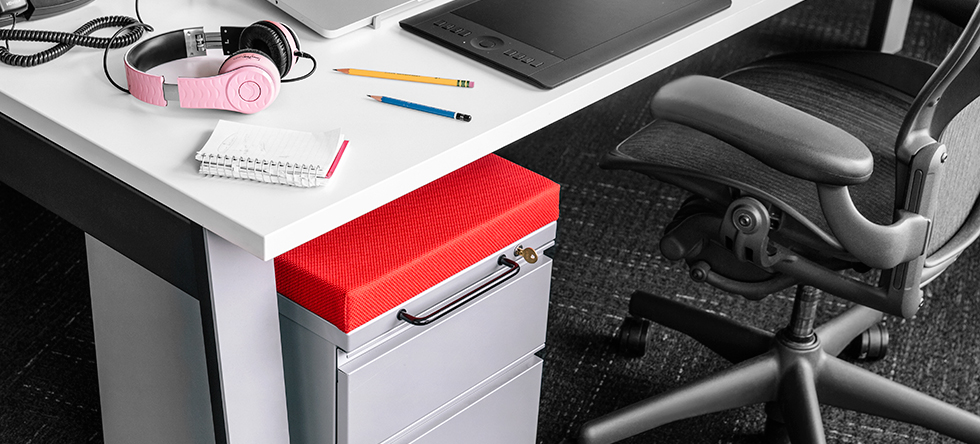
Bill Concannon is a graphic designer by training; Chris Ford is an illustrator. Together, their complementary skill sets can play a critical role in the success of a new or existing product.
When it works, the results are seamless—packaging, store displays, and other materials that all feature a consistent look that tells the story of the brand. The process of getting there, however, often requires several arduous rounds of back-and-forth iteration, often across time zones.
“If an illustrator is working at a desk in Wyoming, getting directed via videoconference with a designer in New York, you’ll get a completely different piece of art,” Concannon says. “The energy and vibe within the studio adds to the collaborative nature and the outcome is a dynamic, useable piece of art that is in line with the designer’s direction.”
So when Concannon and Ford were given the opportunity to collaborate in real time and close proximity while working together at toy and game manufacturer Hasbro in the early 2000s, they flourished. As they began to influence one another in positive ways, not only did their work become more integrated, but their process also began to take shape.
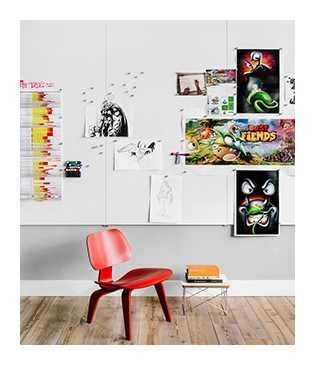
Vertical surfaces throughout the Pilot space offer plenty of opportunities to display work—in-progress illustrations and designs as well as completed projects, which are hung gallery-style along with other artwork to provide inspiration.
As a result, the duo earned numerous design accolades during their five years at Hasbro, but it was their business successes—such as the re-release of the popular electronic game Simon—that gave them the greatest satisfaction.
“With Simon, we refreshed the packaging and that very next year they saw a 500 percent increase in sales, which was attributed largely to the refresh,” Concannon said. “That really made a bold statement. It’s one thing to have another designer say, ‘That’s a great design, we’d like to give you an award,’ but we wanted someone on the business end to say, what you guys did increased sales.”
With this type of validation, Concannon and Ford began thinking about establishing their own studio, a place where artists from both backgrounds—graphic designers and illustrators—could work closely together on projects with the potential to improve the bottom line for clients.
“Billy and I are both artists, so we know firsthand that sometimes it’s hard for artists to find employment—to the point where, when your parents hear that you want to be an artist, they worry about you ever being able to get a job,” Ford said. “We wanted to open a studio where we could show other artists that what they do matters to business.”
Ford and Concannon launched Pilot in 2005. For their first year in business, they operated as a two-person company. A spare room in Concannon’s home served as their first office.
Business grew steadily and within a year Pilot set up shop in a 2,100-square-foot space on the seventh floor of the Boston Innovation and Design Building (IDB), a converted storehouse originally built as part of the South Boston Army Base. With its industrial feel and harbor views, the space was quintessentially Bostonian.
“When it came time to find an office space, we started off by thinking about where we really wanted to be,” Ford said. “When our clients come in from out of town, we want them to know they’re in Boston—and this was it. You’re on the water in a hardworking, blue collar fishing seaport. You can walk down the street and have a lobster, and you actually feel like you’re in New England.”
As the staff expanded to keep up with Pilot’s growing mix of toy and game, entertainment, and food and beverage industry clients, the space began feeling cramped. Then in 2012, the owners were presented with an option to expand into an adjacent 3,000-square-foot space.
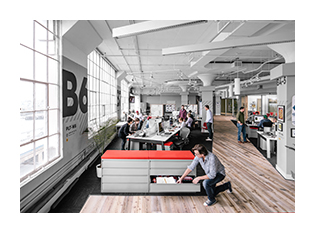
Natural light streams in through the large industrial windows in Pilot's studio—a huge benefit for the artists working there. The views of Boston Harbor have an added benefit. "When our clients come in from out of town, we want them to know they're in Boston," said co-founder Chris Ford.
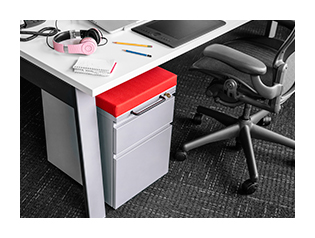
Mobile storage pedestals with cushion tops also function as guest seating when designers and illustrators need to collaborate closely at the benching system they share.
Much like the work Pilot does for clients, designing the studio expansion took a collaborative effort.
“We opened it up to everybody who worked here to share ideas for what they wanted in their dream studio,” Concannon said. “I think at least a piece of an idea from everybody who contributed to that design session is shown somewhere in the studio today.”
The studio’s open layout is broken only along the interior wall by a series of glass-enclosed meeting spaces. Work areas and circulation paths are delineated through variations in flooring. Large windows bring in streams of natural light, which can be augmented as needed with plenty of dimmable, layered overhead lighting. The walls are adorned with graphics that reflect a modern twist on a classic airplane hanger. The bold typography and crosshatching lend a utilitarian, yet warm and inviting feel to the studio. Overall, the chosen aesthetic reflects the hardworking, blue collar origins of the studio and falls succinctly in line with Pilot's brand.
Primary workspaces are Canvas Office Landscape in a benching application, which provides an ideal solution for bringing Pilot’s illustrators and designers together. “Billy and I started this company working on the same desk,” Ford said. “The minute we broke away from each other, I think our production went down 50 percent, so this type of system really works for us. At the end of the day, the result is always a better illustration, always a better design.”
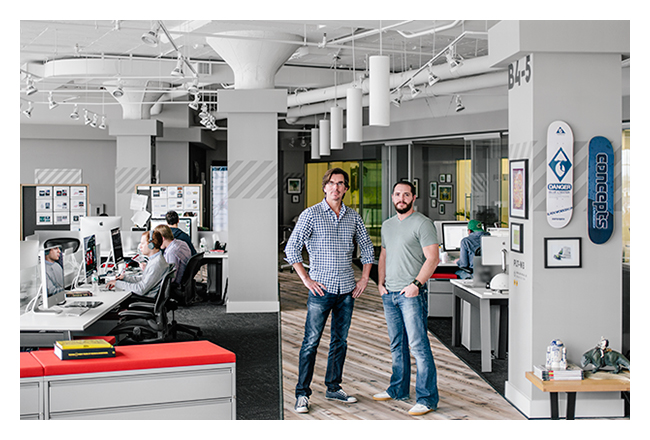
From the lighting overhead to the flooring below and every piece of furniture throughout, Pilot founders and creative directors Bill Concannon (left) and Chris Ford (right) wanted their studio to be a space that supported the designers and illustrators working together there.
The decision to outfit each workspace with Aeron was made during the company’s first year—the year the founders spent working 20+ hour days in Concannon’s house, sitting on uncomfortable kitchen chairs.
“I remember telling Billy—as soon as we can afford it, we’re getting chairs that are comfy,” Ford said. “So we sought out the chair of chairs, and for us, Aeron was it. Then as we started adding more people, we wanted everybody who sits down to work here to be in a chair that is as comfortable as the ones we’re in.”
The net result has become the physical embodiment of the ideal Pilot was founded on—providing an opportunity for artists to do satisfying commercial work, while helping clients build stronger brands through the fusion of illustration and graphic design.
“For us,” Concannon said, “part of retaining talent is building a place people are going to appreciate and love to come to, because when we’re recruiting designers and illustrators, we’re going up against companies like DreamWorks and Pixar and all those huge, fun places to work. There are plenty of talented artists in Boston—we’ve got to do what we can to keep them here, and this space really helps.”
Company Informations:
Le Office Furniture Manufacturer
www.letbackrest.com
Address: No.12, Nanhua Road, LongJiang ,Shunde,Foshan, Guangdong, China (Mainland)
Email: sale@letbackrest.com
skype: kinmai2008

